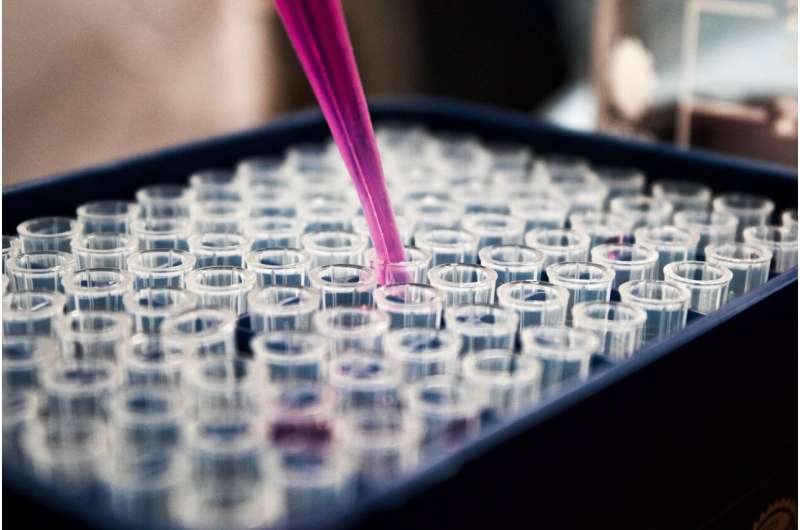This article has been reviewed according to Science X's editorial process and policies. Editors have highlighted the following attributes while ensuring the content's credibility:
fact-checked
peer-reviewed publication
trusted source
proofread
Study identifies high-risk type of childhood acute leukemia and potential treatment strategy

Understanding the molecular characteristics of cancer that impact patient outcomes is essential to identifying novel treatment strategies for the most intractable pediatric malignancies. Many of these diseases are difficult to study, however, due to the small number of patients diagnosed each year.
Investigators from St. Jude Children's Research Hospital and an international collaborative group of more than 50 researchers joined forces to understand better a type of rare childhood leukemia—gamma delta T-cell acute lymphoblastic leukemia (γδ T-ALL).
The findings revealed a high-risk subtype of the disease and a genomic vulnerability that may be targeted by a class of existing drugs. The study was published June 25 in Cancer Discovery.
Acute lymphoblastic leukemia (ALL) represents approximately 30% of all childhood cancers. T-cell acute lymphoblastic leukemia (T-ALL) comprises 15% of childhood ALL, and 10%–15% of T-ALL cases express the gamma delta T-cell receptor, termed γδ T-ALL.
Investigators at St. Jude previously observed poor clinical outcomes among patients diagnosed with γδ T-ALL, however, the disease's rarity led to small numbers of patient samples that made studying the underlying biology of the disease challenging.
"This is a great example of a clinical question that needed to be answered through collaboration," said co-corresponding author Hiroto Inaba, MD, Ph.D., St. Jude Department of Oncology, Division of Leukemia/Lymphoma interim director. "We needed a large collaborative effort to really understand the genetics and get at what is happening in these cases to figure out how to potentially treat them."
The St. Jude investigators turned to the global pediatric leukemia community, identifying 13 clinical study groups investigating T-ALL from which the team could gather data on the γδ T-ALL cases. Altogether, they identified 200 children with γδ T-ALL, making this the largest cohort of the disease yet reported.
With this cohort, the investigators were able to dive into the genomic landscape of the disease, revealing the molecular characteristics that distinguish a high-risk subtype of γδ T-ALL, and a potential way to treat it.

Age and genetic mutations distinguish high-risk γδ T-ALL
T-ALL is rare in infants and very young children. However, the investigators found that when γδ T-ALL does occur in children under 3 years old, the disease has worse outcomes. In addition to age, the researchers also found that the cases with the worst outcomes had a high occurrence of genetic alterations that resulted in both activation of LMO2, a gene commonly altered in other types of T-ALL, and inactivation of STAG2, a gene more commonly altered in acute myeloid leukemia and solid tumors.
"We didn't know going into this study if we would find a single subtype or a single genetic change that would define this γδ T-ALL subtype," said co-corresponding author Charles Mullighan, MD, MBBS, St. Jude Department of Pathology. "But we found quite striking enrichment of STAG2/LMO2 alterations and were able to dig into that to understand the rearrangement and the impact it was having on the biology of the disease."
Using patient samples, xenograft models and genetically manipulated cell lines, the researchers showed that inactivation of STAG2 has a profound effect on the organization of chromatin (imagine a spool around which DNA is wound). STAG2 inactivation disrupts gene expression associated with the differentiation (maturation) of T-cells by altering enhancer-promoter looping (the way that instructions about which genes should be expressed are conveyed).
"Chromosomal rearrangement between two genes is a hallmark of leukemia, but what we found was different because what this alteration does is switch STAG2 off, taking the STAG2 promoter and moving it proximal to LMO2, switching it on," explained Mullighan. "This dual mechanism is unusual and provides insight into the biological consequences of these changes to explain what is going on at the genomic level in this rare cancer."
"What this work really underscores is that when patients with T-ALL arrive in the clinic, you need to identify those with this γδ T-ALL subtype," added Mullighan. "Recognizing this subtype so that treatment can be tailored accordingly is incredibly important for patients."
A potential treatment strategy emerges
In addition to gaining a more complete picture of the underlying genomics fueling the poor outcomes observed clinically in γδ T-ALL, the study also highlighted a potential treatment strategy: Poly(ADP-ribose) polymerase (PARP) inhibitors.
DNA is damaged throughout one's life, so the human body has built-in DNA repair mechanisms. However, many cancers hijack these DNA repair pathways to make the body more hospitable to cancer cells and their irregular DNA. PARP is part of one of these DNA repair pathways, and existing drugs to inhibit it have shown success in several cancers.
The researchers conducted drug screening and pharmacogenomic analyses to identify therapeutics with the potential to treat γδ T-ALL. PARP inhibitors emerged as the compounds with the most promise.
"This is very exciting to identify a potential targeted therapy for these patients who have typically poor outcomes," said Inaba. "Many cases of ALL are curable, but some are not yet and that's where we need to focus. Targeted therapies can provide a new option and may even be able to reduce the side effects or late effects of treatment by targeting the cancer cells more directly."
"This story is not the end," added Inaba. "By having these genomic and clinical datasets we will continue to search for better treatments."
More information: Shunsuke Kimura et al, Biologic and clinical analysis of childhood gamma delta T-ALL identifies LMO2/STAG2 rearrangements as extremely high-risk, Cancer Discovery (2024). DOI: 10.1158/2159-8290.CD-23-1452


















